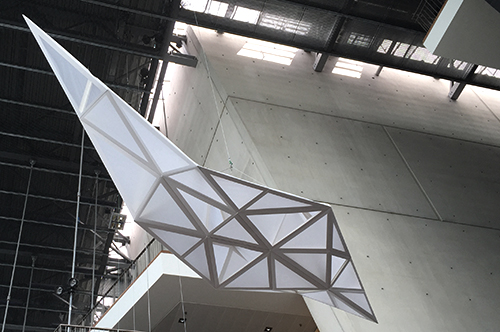
foldKITE
2015
Design and Construction: Pierluigi DʼAcunto, Juan Jose
Castellon, Alessandro Tellini (Raplab), Shibo Ren (Arup Amsterdam)
Collaborators: Jonas Hodel, Leo Kleine
The use of folding in design allows for the production of efficient structures capable to resist the external applied loads by form;
additionally, folding is an effective way to generate forms that can address diverse spatial necessities. Developed as an entry to the
IASS Expo 2015 out of a collaboration between the Chair of Structural Design at ETH Zürich, the Rapid Architectural Prototyping Laboratory
(Raplab) at ETH Zürich and Arup Amsterdam, the project foldKITE aims to explore the potentials of folded-plate systems in the field of
ultra-lightweight structures.
foldKITE consists in a suspended structure with overall dimensions of 5.0m x 1.5m x 1.25m. Inspired by the aviation sector, the geometry
of foldKITE has been generated using a novel design method for the integration of structural folding in architecture that is based on a
three-dimensional design process grounded on simple geometric operations. Following the design method, a surface has been virtually folded
within a predesigned tetrahedral grid, thus generating a folded-plate system that, due to its inherent properties, also performs
structurally. In fact, thanks to the utilization of a tetrahedral grid, it is possible to activate within the folded surface a load-
bearing system that is equivalent to a pin-jointed three-dimensional truss where the folded edges represent the rods of the truss, loaded
either in tension or compression, and the vertices correspond to the hinged nodes. By additionally pre-stressing the folded surface, a
structural system working similarly to a stressed skin can be deployed.
The materialization of the full scale prototype of foldKITE has taken advantage of the use of ultra-lightweight materials as well as of
the construction techniques employed in the kite industry. Specifically, the plates of the folded surface have been produced using a
polycarbonate film with polyester strands and they have been reinforced along the edges with 1mm-thick paperboard elements mounted
directly onto the fabric. The plates have been shipped to the site as individual elements and then assembled at the Muziekgebouw in
Amsterdam using a flap-to-flap connection system. Thanks to the employment of ultra-lightweight materials, the total mass of foldKITE does
not exceed 8.0 kg, giving the structure the appearance to float in the air.
last modified 29.11.2019